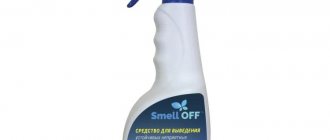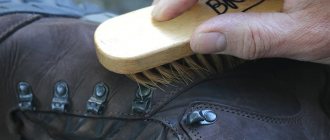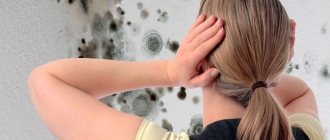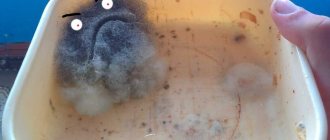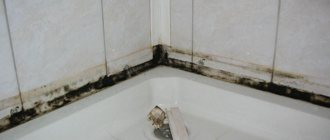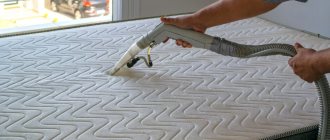If an unpleasant odor is detected in the closet with clothes in a house or apartment, the shelves smell of dampness, this is evidence that there is mold in the room. Anyone can encounter such an unpleasant phenomenon. Before entering into a fight, it is worth understanding the reasons for its occurrence. First you need to determine where the excess moisture comes from. Fixing the problem and getting rid of the smell of mold in the closet forever is only possible after identifying and destroying the original source.
What can cause an unpleasant odor?
Foreign odor may appear for various reasons. The main one is mold. In conditions of high humidity and stable temperature, mold microorganisms actively multiply, and in a closed chest of drawers, their metabolic products quickly begin to give off a characteristic odor that is difficult to get rid of.
Causes of mold:
- Placing insufficiently dried clothes in the closet;
- Formation of excess humidity inside due to the presence of dampness in the room.
Wood absorbs moisture (and odors) well, creating comfortable conditions for mold. Getting rid of it is the first priority.
Another unpleasant smell found in old chests of drawers is mothballs. Previously, balls containing this substance were used against moths, but their persistent odor can persist for decades.
The ability of wood to absorb causes the presence of odor in almost any antique furniture, unless special measures have been taken to get rid of it. An old musty smell is formed by a complex mixture of aromas that have ever been in a given piece of furniture.
Finally, the presence of smokers or active athletes in the house are two more reasons for the appearance of an unpleasant odor.
Reasons for the appearance of “aroma”
It can appear for a number of reasons:
- A specific smell from new furniture. As a rule, it goes away with time.
- Dampness (mold) and mustiness. They appear most often in old pieces of furniture or when they are incorrectly positioned. It is not recommended to place a wardrobe near an adjacent wall with a bathroom or kitchen.
- Improper storage of things. You cannot put something that has been worn at least once in a closet with clean clothes. Such things already “have” their own smell. They could be saturated with strong-smelling vapors and smoke (for example, from cigarettes), then, with deodorant, which means they could fill the wardrobe with the corresponding “aroma.”
- Lack of ventilation. In a confined space, such as a closet, over time the air becomes stale. This is also affected by underwear that has not been used for a long time (several months, a year).
Preparation
Before you can get rid of the smell in your closet, you need to remove it from your clothes. Mold can grow in the cells of the fabric, so clothing should be carefully inspected.
Furniture should also be inspected for visible signs of mold. If we are talking about old furniture, then you can easily find an ancient mothball that has been ruining your life all this time.
Try moving furniture away from the wall. In some cases, this eliminates the problem since the source of the mold is located there.
After emptying the wardrobe and all cabinets, remove the shelves. After this you can start working.
Getting rid of mustiness
What to do if it smells musty? The problem appears if you do not clean your closet for a long time and store old things in it that are not used for a long time. An air freshener is not effective in removing unpleasant odors in this case.
To eliminate mustiness, you need to periodically inspect your wardrobe (at least 2 times a year when changing cold and warm seasons) and remove unused items.
If clothes are not used, but may be useful, then they need to be placed in bags. It is advisable to use vacuum ones, which close tightly, allow you to optimize space and ensure high-quality storage of things.
In addition, a musty smell can appear when dirty (used several times, sweaty) clothes are in the wardrobe. It is advisable to immediately put it in a container for dirty laundry.
Note: This also applies to towels, which, due to frequent or improper use, begin to emit a musty smell. We recommend that you familiarize yourself with how to remove it.
The audit of the closet should be accompanied by its general cleaning. After that you should put in it:
- pieces of your favorite scented soap wrapped in cloth (also prevents moths);
- dried citrus zest (orange or tangerine);
- bags made of cotton fabric with fragrant herbs and spices;
- coffee beans in an open jar;
- perfume bottles and samples.
How to get rid of mold smell in a closet
There are several ways to get rid of the smell. Let's look at the most popular and effective of them.
Flavors
Available in different types and with different scents. The main problem is that these are concealers. They do not eliminate the cause of the smell, but replace it with a more pleasant one. This method will not help get rid of the problem, however, as a temporary measure, flavorings are quite suitable.
Separately, we note the situation of smokers. As a rule, no one is going to fight the root cause, so flavorings can be used for a long time. It is recommended to choose special types of deodorants with anti-smoking properties.
Drying and ventilation
This method will help get rid of excess odors in places with high humidity. It consists of the following:
- The closet, emptied of clothes, must be thoroughly dried. It is recommended to do this using a heat gun or heating devices.
- Ventilation of chests of drawers must be carried out monthly.
Treatment of internal surfaces
If the situation is advanced, and obvious traces of mold are visible inside, then the surface of the cabinet should be treated with special compounds. To get rid of mold, aqueous solutions of the following substances are used:
- Soda;
- Hydrogen peroxide;
- Ammonia;
- Vinegar.
The easiest way to treat a cabinet is with baking soda due to its relative safety for humans. Wipe the interior surfaces of the cabinet with the solution and leave for several hours. Then, wipe the wardrobe with a slightly damp cloth and dry.
If soda does not help get rid of mold, then use more powerful formulations based on ammonia or hydrogen peroxide. After using these substances, you will have to use flavorings, since ammonia and peroxide themselves smell unpleasant.
Milk bath
Boil milk in a saucepan and place it in the cupboard. Close all doors and wait until the milk has cooled (clothes must be removed). The thermal effect of steam (especially milk steam) will effectively get rid of mold microorganisms. Please note - the stagnant milky aroma is also not very pleasant, which brings us back to the use of flavorings.
Odor absorbers and sachets
There are substances that can absorb various odors. These include:
- Salt (regular, table salt);
- Soda;
- Coffee;
- Activated carbon.
To remove odors from your clothing closet, place open containers containing one of these substances (or a mixture of them) on its shelves. Be careful with activated carbon. It absorbs odors most effectively when crushed. However, in this state it smudges a lot.
Another option is a sachet. This is a special dry composition, packed in a linen bag, which performs two functions: absorbs unpleasant odors and distributes pleasant ones. To achieve the effect, place the sachets in different places in the closet.
Various herbal infusions or citrus peels can also remove the smell of dampness, tobacco or sweat while simultaneously replacing it with something more decent.
How to get rid of tobacco smell
If the use of flavorings no longer helps you, the following set of measures will help get rid of the tobacco smell (assuming that the smoker has not yet quit):
- Do not put clothes that you smoked outside in the closet without first airing them for a couple of hours;
- Ventilate furniture regularly;
- Once a month, remove all clothing from it and wipe the surface using vinegar diluted in water.
Shoe cabinet
In some cases, the scents of a shoe closet can be used to torture. The reason lies in the bacteria that settle in shoes. The smell should be eliminated first of all by working with your shoes. This is done like this:
- Regular replacement of insoles;
- Whenever you feel that your shoes are wet (whether due to rain or sweat), they must be dried thoroughly;
- For prevention, all shoes should be periodically removed from the shelves and aired;
- Likewise, the closet also needs ventilation.
Shoe polish can also have a specific smell. Modern brands of shoe care products contain special fragrances, but not all of them. There are two ways to get rid of this problem: rub your shoes with cream less often or use a different composition.
The smell of sweat
Everything is simple here - do not put clothes that have traces of sweat in your closet. First, wash or at least dry. For everyday items, select a separate shelf in which to place fragrances.
Coffee beans or citrus peels will help get rid of the unpleasant smell in the closet. They mask the smell of sweat best.
Musty smells of old furniture
Appear due to the use of naphthalene (against moths) or as a result of the accumulation of various aromas over the entire period of use of the cabinet. It is the most difficult to eliminate such stagnant odors, since they have already been absorbed into the wood. Simply cleaning out the closet will not be enough - an integrated approach is required.
The inner surface should be wiped with a strong solution of ammonia or vinegar. After drying, place containers with coffee beans on shelves - they perfectly mask the residual aromas of naphthalene.
Soap
Some people use pieces of toilet soap as a fragrance. However, this method is recommended only as a short-term method. During long-term “dry” storage, the smell of soap changes towards more musty and stagnant.
If you do not replace the soap bars with new ones, the result will be no better than the original problem.
What to do if clothes and shoes smell damp
If mold gets on things, you need to act quickly. To begin with, clothes are hung out in the fresh air and sun. Can be left for 3 or more days. After drying, treatment with special products is recommended.
Light or white things
Can be treated with hydrogen peroxide or bleach. The substances will quickly remove the stench and return it to its previous appearance. Soak the product and leave it for several hours. Wash with regular powder and rinse with fabric softener. The procedure is aggressive! May damage delicate, delicate fabric.
Colored products
It is optimal to use ammonia. It is mixed halfway with ammonia, and the finished product is applied to the site of contamination. After treatment, wash in warm water using a stain remover or strong powder.
Bedding set and cotton
To restore freshness, a simple product is suitable - onions. Rub freshly squeezed juice onto moldy areas and wash in warm water. You can use curdled milk; the soaking period lasts up to 12 hours.
- How to clean mold on plastic windows and slopes
- In what cases can mold appear in an apartment?
- Fighting the smell of dampness in the apartment
Products made from natural fabrics
Vinegar and freshly squeezed lemon juice are used for cleansing. Combine in equal quantities, pour onto the stain, sprinkle with a small amount of salt on top. Allow the fabric to dry and wash.
Linen
Fungus on linen clothes is removed with a mixture of ammonia 20 g, water 1 liter, table salt 20 g. Mix, put the product to boil on the stove for half an hour. Soak the item for a couple of hours, wash it by hand or in a machine, and dry it.
Prevention
It is easier to prevent the appearance of mold odor than to get rid of it later. For this:
- Store clean clothes separately from those you wear.
- Place only dry clothes in the closet.
- Do not dry clothes indoors (at least not in the kitchen).
- Do not place the wardrobe close to the wall, especially if the wall is problematic (has traces of mold).
- Ventilate the closet regularly, emptying it of everything that is inside.
(Visited 10,804 times, 10,804 visits today)
Share
The most unexpected places for mold to form
The appearance of fungal plaque is always accompanied by such factors as an increase in humidity and dampness, which is absorbed by furniture, walls, and ceilings. Due to its structure, mold fungus has an unlimited ability to penetrate deep into walls and furniture. The possibility of reproduction in a damp and humid environment increases several times, which results in a lightning-fast increase in lesions. Over time, clothing becomes infected. Rot in a closet can cause enormous damage to furniture and belongings. It is possible to detect mold only by completely checking the contents of things, the back wall of the cabinet, storage shelves, and the corners of the walls. Only after determining the location of the source of infection can we begin to eliminate the problem that has arisen. I recommend reading the article “How to get rid of mold in an apartment?”
What to do with fungus on clothes?
It’s not enough to get rid of mold in your locker; you also need to clean it from your clothes. After all, if the spores remain on things, then again you will have to fight the fungus.
If financial capabilities allow, then all items can be dry cleaned. There, clothes are treated with special substances that kill fungi.
If this is not possible, then you should use traditional methods.
Ammonia . Mix equal portions of water at room temperature and ammonia. Now wipe the affected areas of things with the solution. After the procedure, wash your clothes. You cannot use ammonia undiluted, as this will harm things.
Curdled milk . Pour yogurt into the washing basin and place the necessary things in it, which should first be rinsed under running water. After 6-8 hours, take out the clothes and wash them.
Onion juice . Grate the onion and apply the paste to the affected areas. Wait five minutes and rinse it off under running water. After this, wash everything you need to get rid of the onion smell. After washing, iron items if they can be ironed.
Chalk . Suitable for cotton fabric. Grind the chalk and sprinkle it on the desired areas of the fabric. Now cover with a damp cloth and iron with a well-heated iron. The chalk will absorb stains. The procedure should be repeated several times. After ironing, wash your clothes with laundry soap.
Laundry soap . Pour warm water into a bowl, crumble the soap into it and create a lot of foam. Now place the necessary things in the basin and let them soak in the water for a while. In an alkaline environment, aspergillus will die, and things will no longer be infected with it. After this procedure, the laundry should be rinsed well, dried and ironed.
Whiteness . A unique product that not only whitens things, but also disinfects them. It is best to boil bed linen, towels and suitable items with bleach. Place all the necessary things in a basin and boil for 15 minutes. After this, wash with powder, dry in the sun and iron.
Necessary actions to prevent fungal infection
To begin combating fungal mold, you need to make sure that the root cause of the mold has been eliminated. Since when the fungus is removed superficially, its reappearance is guaranteed. It is easier to prevent the occurrence of any contagious infections than to eliminate their consequences later. Preventative actions against mold:
- ventilate the premises (2-3 times a day);
- if necessary, it is necessary to install forced ventilation;
- during repairs and construction, use antiseptic preparations;
- monitor the condition of plumbing fixtures and, if necessary, repair damage or leaks that lead to dampness.
Furniture processing
Carry out the treatment only after the closet is completely empty of clothes. Today, there are several simple methods that can at the same time kill harmful spores and save wood from further damage. Let’s look at the 2 most effective ones.
The most common method is to treat wood with soda solution. This method is suitable even for a cabinet with children's underwear, as it is safe. Dissolve 3 tbsp in a liter of water. l. soda, then wash the inside of the cabinet with the resulting solution, including all sides, shelves, walls and doors. Leave the cabinet open for 4 days. You can also use hydrogen peroxide. Treating children's cabinets with peroxide is as safe as using soda.
See also: How to deal with mold on the ceiling?
Another effective method is chlorine bleach. But keep in mind that this method of dealing with the problem is not suitable for everyone, since chlorine causes an allergic reaction in many people. The method is suitable for processing a closet where the clothes of adult family members are stored. Carrying out such treatment is unacceptable for disinfecting children's furniture.
First, you should remove all clothes from the closet and dry the inner surface using a special dryer or fan, and only then proceed directly to disinfection. It is better to take the wardrobe out of the room into the open air so as not to breathe in harmful fumes.
Mix equal parts water and chlorine bleach, put on gloves and use the resulting solution to wipe all the walls and shelves of the cabinet, inside and out. When done, wash the cabinet with clean water. It is advisable for the wardrobe to stand for about 3 days in the fresh air, which will help eliminate the unpleasant smell of chlorine.
When processing wardrobes using this method, you do not need to add additional detergents to the water so as not to harm your health. Using bleach allows you to completely clean the surface, which ordinary soda, which is best used at the initial stage of infection, cannot cope with.
